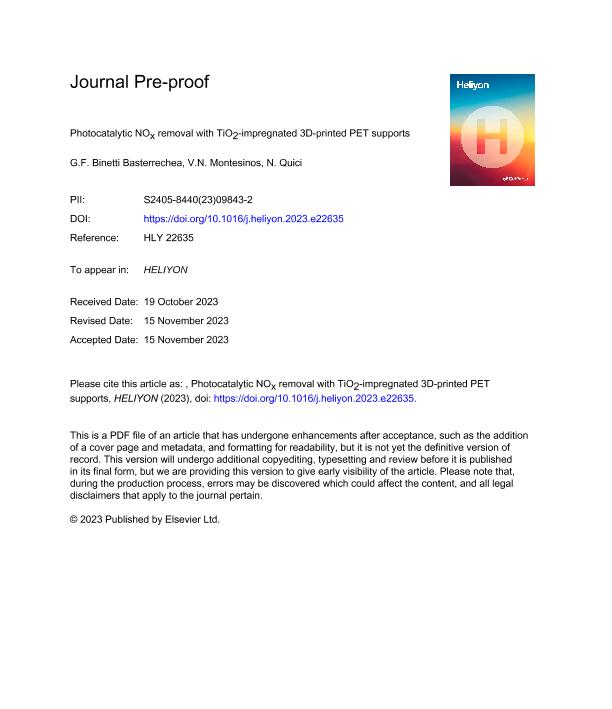Mostrar el registro sencillo del ítem
dc.contributor.author
Binetti Basterrechea, G. F.
dc.contributor.author
Montesinos, Victor Nahuel

dc.contributor.author
Quici, Natalia

dc.date.available
2023-12-06T17:31:59Z
dc.date.issued
2023-11
dc.identifier.citation
Binetti Basterrechea, G. F.; Montesinos, Victor Nahuel; Quici, Natalia; Photocatalytic NOx removal with TiO2-impregnated 3D-printed PET supports; Elsevier; Heliyon; 9; 11-2023; 1-28
dc.identifier.issn
2405-8440
dc.identifier.uri
http://hdl.handle.net/11336/219563
dc.description.abstract
In this work, we investigated the photocatalytic removal of NOx using 3D-printed supports. Monolithic supports withinternal channels were fabricated by Fused Modelling Deposition (FDM) using PET as the filament feedstock. Theprinting parameters of the supports were optimized to maximize the exposure of the photocatalyst to UV lightthroughout the monolithic PET printed supports. The removal experiments were carried out in a continuous gasphase flow reactor, which was custom designed in-house incorporating a 3D printed PET support impregnated withTiO2 as photocatalyst. The impregnated and non-impregnated supports were characterized by diffuse reflectancespectrometry, SEM and AFM. The effect of several key-factors on the NOX removal capacity was investigated,including the type of PET filament (native recycled, BPET vs. glycol-modified, PETG), the type of TiO2 (P25 vs HombikatUV-100), the UV light source (LED vs. tubular lamps), and the number of deposited TiO2 layers. The highest NO andNOx removal were achieved by using PETG supports coated with a single layer of Hombikat UV-100 and irradiatingthe flat reactor from both sides using two sets of black light lamps. However, the highest selectivity toward nitrateformation was obtained when using P25 under the same experimental conditions. This work demonstrates that 3Dprinting is a reliable and powerful technique for fabricating photocatalytic reactive supports that can serve as aversatile platform for evaluating photocatalytic performance.
dc.format
application/pdf
dc.language.iso
eng
dc.publisher
Elsevier

dc.rights
info:eu-repo/semantics/openAccess
dc.rights.uri
https://creativecommons.org/licenses/by-nc-sa/2.5/ar/
dc.subject
3D PRINTING
dc.subject
PET
dc.subject
PHOTOCATALYSIS
dc.subject
NOX
dc.subject.classification
Otras Ingeniería Química

dc.subject.classification
Ingeniería Química

dc.subject.classification
INGENIERÍAS Y TECNOLOGÍAS

dc.title
Photocatalytic NOx removal with TiO2-impregnated 3D-printed PET supports
dc.type
info:eu-repo/semantics/article
dc.type
info:ar-repo/semantics/artículo
dc.type
info:eu-repo/semantics/publishedVersion
dc.date.updated
2023-12-06T14:56:05Z
dc.journal.volume
9
dc.journal.pagination
1-28
dc.journal.pais
Países Bajos

dc.description.fil
Fil: Binetti Basterrechea, G. F.. Universidad Tecnológica Nacional; Argentina
dc.description.fil
Fil: Montesinos, Victor Nahuel. Consejo Nacional de Investigaciones Científicas y Técnicas; Argentina. Universidad Tecnológica Nacional; Argentina. Comisión Nacional de Energía Atómica. Gerencia del Área de Seguridad Nuclear y Ambiente. Gerencia de Química (CAC); Argentina
dc.description.fil
Fil: Quici, Natalia. Universidad Tecnológica Nacional; Argentina. Consejo Nacional de Investigaciones Científicas y Técnicas; Argentina. Comisión Nacional de Energía Atómica. Gerencia del Área de Seguridad Nuclear y Ambiente. Gerencia de Química (CAC); Argentina
dc.journal.title
Heliyon
dc.relation.alternativeid
info:eu-repo/semantics/altIdentifier/url/https://linkinghub.elsevier.com/retrieve/pii/S2405844023098432
dc.relation.alternativeid
info:eu-repo/semantics/altIdentifier/doi/http://dx.doi.org/10.1016/j.heliyon.2023.e22635
Archivos asociados
